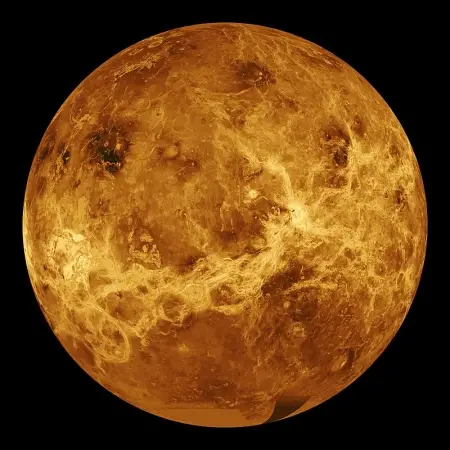
Venus is the second planet from the Sun in our solar system. It is often called "Earth's twin" due to its similar size and composition, although it presents extreme conditions that contrast drastically with those of our planet.
On this planet, days are longer than years.
General characteristics
Venus has a diameter of approximately 12,104 kilometers, only slightly smaller than Earth's diameter of 12,742 kilometers. Its mass is approximately 82% of the mass of the Earth, which also reinforces the comparison with our planet.
However, this is where the similarities end. The atmosphere of Venus is extremely dense and toxic and is composed mainly of carbon dioxide (96.5%) and thick clouds of sulfuric acid.
|
Position in the Solar System |
Second planet from the Sun |
|
Diameter |
Approximately 12,104 km |
|
Time |
4.87 × 10^24 kg (82% of Earth's mass) |
|
Gravity |
8.87 m/s² (90% of Earth's gravity) |
|
Rotation (sidereal day) |
243 Earth days, in retrograde direction (rotates in the opposite direction to most planets) |
|
Translation (orbit around the Sun) |
225 Earth days |
|
Solar day length |
117 Earth days |
|
Surface temperature |
Approximately 465°C |
|
Atmospheric pressure |
Approximately 92 times Earth's atmospheric pressure |
|
Atmosphere |
Composed mainly of carbon dioxide (96.5%) and clouds of sulfuric acid |
|
Surface |
Full of volcanic plains, mountains and craters; mapped primarily by radar due to its dense atmosphere |
|
Magnetic field |
Virtually non-existent compared to Earth |
|
atmospheric winds |
Speeds up to 360 km/h in the upper atmosphere |
|
Space exploration |
Visited by missions such as the Venera probes (Soviet Union), Pioneer Venus and Magellan (NASA) and future missions such as DAVINCI+, VERITAS (NASA) and EnVision (ESA) |
|
Scientific importance |
Studies on the greenhouse effect, planetary evolution and atmospheric dynamics |
Rotation and translation
One of the most surprising aspects of Venus is its rotation. It rotates on its axis in a retrograde direction, that is, in the opposite direction to that of most of the planets in the solar system, including Earth.
One day on Venus (the time it takes to rotate once on its axis) is equivalent to 243 Earth days, and it does so more slowly than its own orbital period around the Sun, which is about 225 Earth days. This means that on Venus, a day is longer than a year.
The linear speed of Venus in its orbit around the Sun is approximately 34,974 km/h. This means that Venus is moving at high speed along its elliptical path around the Sun. This high speed is a consequence of its relative proximity to the Sun, as closer planets tend to orbit more quickly due to the intense gravitational pull.
On the other hand, the angular velocity of Venus is approximately 3.23 × 10⁻⁷ radians per second. Despite its fast linear speed, the great distance traveled around the Sun makes its angular speed relatively low.
Temperature and pressure
Venus is the hottest planet in the solar system, with surface temperatures reaching 465 degrees Celsius.
This extreme temperature is due to an uncontrolled greenhouse effect: the dense carbon dioxide atmosphere traps the Sun's heat, preventing solar radiation that bounces off its surface from escaping into space.
Furthermore, the atmospheric pressure on the surface of Venus is about 92 times greater than that on Earth, comparable to the pressure found 900 meters underwater on Earth.
Surface and geology
 The surface of Venus is relatively young, geologically speaking, with vast volcanic plains and large mountains.
The surface of Venus is relatively young, geologically speaking, with vast volcanic plains and large mountains.
Radar images obtained by missions such as NASA's Magellan have revealed the presence of numerous volcanoes, many of which appear to have been active in recent geological times.
However, there is no direct evidence of current volcanic activity. Lava plains, impact craters, and tectonic features indicate a dynamic planet, although plate tectonics are not observed as on Earth.
Atmosphere and climate
Venus's atmosphere is dense and opaque, making the surface invisible in light visible from space. However, observations at other wavelengths, such as radar, have made it possible to map its surface.
Clouds of sulfuric acid in Venus' upper atmosphere reflect light from the Sun, making it the brightest object in the night sky after the Moon.
The winds in the upper layers of Venus' atmosphere are extremely fast, reaching speeds of up to 360 kilometers per hour. These winds circulate around the planet in just four Earth days, contrasting with the slow rotation of the planet itself.
Exploration of Venus
Venus has been an object of interest and exploration since the early days of the space age.
The Soviet Union was the first to send a probe to Venus, with the Venera program, which accomplished several notable feats, including the first soft landing on the surface of another planet (Venera 7 in 1970) and the first images of the surface (Venera 9 in 1975).
NASA has also contributed significantly to the study of Venus with missions such as Pioneer Venus and Magellan, which provided detailed maps of the planet's surface.
Why is it called Venus?
Venus owes its name to the Roman goddess of love and beauty. This nomenclature dates back to ancient times, when the Romans, following the tradition of the Greeks, began to associate the visible planets with their most important deities. The Greeks had called the planet Aphrodite, after their goddess of love and beauty, and the Romans adopted this name, reducing it to Venus.
The planet Venus is one of the brightest objects in the night sky, surpassed only in brightness by the Moon. Its intense glow and visibility at both dawn and dusk likely influenced its association with the deity representing beauty and love.